ISSN ONLINE(2319-8753)PRINT(2347-6710)
ISSN ONLINE(2319-8753)PRINT(2347-6710)
R.C. Mohanty 1, Rajendra Kumar Mohanty 2, B.K. Nanda 3
|
| Related article at Pubmed, Scholar Google |
Visit for more related articles at International Journal of Innovative Research in Science, Engineering and Technology
Damping in built-up structures is produced by the energy dissipation due to micro-slip along the frictional interfaces. The analysis of the problem has been carried out using Finite Element Method (FEM). A finite element model of the linear elastic system has been formulated using the Euler-Bernoulli beam theory to investigate the damping phenomena in riveted connections. The discrete element system having two degrees of freedom per node representing v and v x has been used for the analysis. The solution considers one-dimensional beam elements with each one consisting of two nodes having two degrees of freedom, i.e. transverse displacement and rotation at each node. The generalized stiffness and mass matrices for this element has been derived. Extensive experiments have been conducted for the validation of the analysis. From this study, it is established that the damping capacity increases and the natural frequency decreases due to the joint effects.
Keywords |
| Shape function; stiffness matrix; interface pressure; micro-slip; damping capacity. |
INTRODUCTION |
| Usually, the fabricated or built-up structures possess low material damping which can be adequately compensated by incorporating suitable joints to construct the same. The contribution of damping due to joints to such structures depends largely upon its behavior under dynamic conditions. Gropper [1] and Menq et al. [2] have shown that joints usually exhibit two types of motions; micro-slip and macro-slip. The micro-slip usually occurs with small relative displacement between the contacting members resulting in energy losses at the joints causing the damping of the structures. Beards [3] has performed a series of experiments on the damping of the joints to control the vibration of a structure and established that the damping in joints is much larger compared to the material damping and there exists an optimum clamping force at which the energy dissipation is maximum. Shin et al. [4] have shown that the damping effect is negligible when the joint is very tight. They further established that the natural frequency decreases and the damping capacity increases with the loosening of the joint. Damisa et al. [5] have studied the effect of non-uniform interface pressure distribution on the mechanism of slip damping for layered beams. However, their analysis is limited to static load and linear pressure profile. Further, Olunloyo et al. [6] have also studied the damping mechanism with polynomial and hyperbolic forms of interfacial pressure distribution. |
| Many boundary and initial value structural engineering problems are solved with the application of finite element method (FEM). However, its application in damping analysis is relatively recent. Gaul and Lenz [7] have worked in details on the finite element models of different slip mechanisms to study the dynamic response of assembled structures incorporating both the micro- and macro-slip of several bolted/riveted joints. Chen and Deng [8] have proposed a finite element method for understanding and characterizing the non-linear damping behavior of structural joints. Hartwigsen et al. [9] have found out the contact area of bolted joint interfaces using FEM analysis and they further conducted the experiments to verify the same. Sainsbury and Zhang [10] have used finite element analysis through Galerkin element method (GEM) to study the dynamic analysis of damped sandwich beam structures. . Lee et al. [11] used the finite element model of a jointed beam to obtain the natural frequencies and mode shapes. Oldfield et al. [12] have investigated the damping of an assembled structure using the dynamic frictional contact analysis under harmonic loading by the finite element analysis. |
| Although, a lot of analytical, computational and experimental works have been carried out by several researchers in the recent past on the damping of bolted structures, but no substantial work has been reported till date on the damping capacity of riveted structures. Hence, an attempt has been made in the present investigation to analyze the damping mechanism in assembled structures using the finite element models and to study the effect of various parameters on the damping of layered and jointed cantilever beams having thickness ratio of 1.5. Further, the finite element model analysis has been validated with experiments. |
| The finite element method is widely employed to solve many boundary and initial value engineering problems and its application in damping analysis has been studied by many researchers [1-4]. Among the work done by many authors, Nanda and Behera [5] have studied damping in layered and jointed bolted structures using the classical energy approach. However, a very little amount of work has been reported till date on the damping characteristics of riveted joints. Further, the bolted and riveted joints exhibit different damping behavior because of varying interface pressure distribution characteristics and zone of influence under similar dynamic conditions. A finite element approach based on the energy dissipation mechanism has been presented to investigate the damping in jointed and riveted structures. |
FINITE ELEMENT FORMULATION |
| A standard discretized beam element has been modeled using two nodes with each one consisting of two degrees of freedom (translation and rotation) as shown in Fig. 1. Assuming that each layer has the same transverse displacement and rotation at any section, the deformation within the eth element v(x,t) is approximated using the standard cubic shape function S(x) as; |
 |
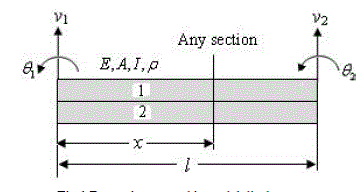 |
 |
 |
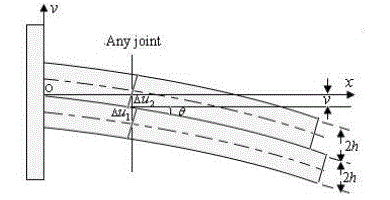 |
 |
 |
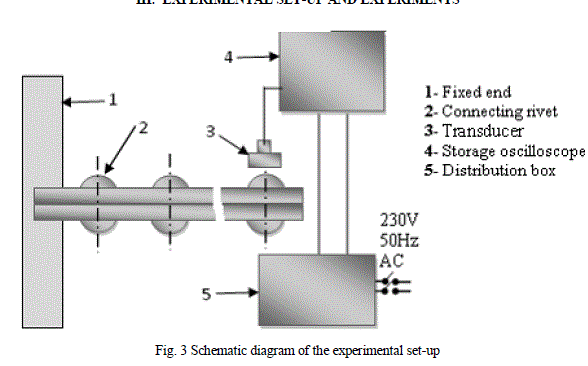 |
| A schematic diagram of the experimental set-up for conducting experiments is shown in Fig. 3. Initially, the Young’s modulus of elasticity (E) is found out from a sample solid beam specimen by static bending deflection test and its average value is found as 196.8 GPa. The specimens are prepared from mild steel flats using power driven rivets as presented in Table 1. The distance between the consecutive rivets, width and length of specimens are varied as per the zone of influence. The tests are conducted after mounting the specimens rigidly to the support. A digital storage oscilloscope coupled with a transducer records the oscillations and frequency of vibration. The logarithmic decrement has been found out using the expression δ ln = a1 an 1 ( n )/ n , where a1, an+1 and n are the amplitudes of the first cycle, last cycle and number of cycles respectively. The average value has been taken by repeating each test at least for five times to minimize the experimental errors. |
 |
| The energy dissipation principally depends upon the kinematic coefficient of friction (μ) and dynamic slip ratio (α) at the interfaces. These two parameters exhibit complicated behavior under dynamic conditions. Moreover, they are interdependent and inversely related. However, their product (α.μ) being frequency and amplitude dependent is established to be constant for a particular specimen irrespective of any surface condition. In order to authenticate this, a number of jointed beams with varying surface roughness at the interfaces have been tested and the logarithmic decrement is found to be almost the same. Hence, this product has been determined from the experimental results of logarithmic decrement at a particular rivet diameter using Eq. (11), whose variation with frequency and amplitude is presented in Fig. 4. These values are subsequently used to find out the damping with respect to other diameters using Eq. (10). |
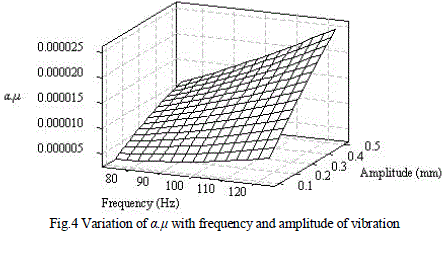 |
DISCUSSION OF RESULTS |
| The finite element approach is an efficient tool for the dynamic analysis of jointed structures. As the direct formation of damping matrix for interfacial slip damping is very difficult, an alternate energy approach has been used to derive the damping as presented in Eq. (10). In this regard, the expressions for dynamic slip, input strain energy and energy loss in a jointed beam are formulated using the stiffness matrix, shape function and displacement vector. |
| Experiments are conducted with a number of specimens to obtain the logarithmic decrements corresponding to 10 mm diameter rivet. From these results, the product “α.μ” corresponding to each value of logarithmic decrements is computed using Eq. (11). Further, the logarithmic decrements for the specimens connected with different rivet diameters are found out numerically using Eq. (10). The plots presented in Figs. 5 and 6 give a good comparison between both the results with a maximum variation of 2.3 %. The higher values of the experimental results are due to material and support damping which have been neglected in the theoretical analysis. The influence of the following parameters on the damping is explained below: |
| Effect of the rivet diameter:- The use of the rivets of larger diameter increases the normal force and energy dissipation at the interfaces. Moreover, the stiffness increases with the rivet diameter introducing more input strain energy as evident from Eq. (7). But the energy dissipation due to friction occurs at a higher rate compared to the input strain energy, thereby increasing the logarithmic decrement as presented in Fig. 5. |
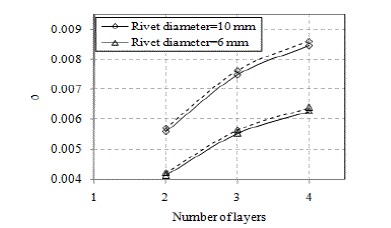 |
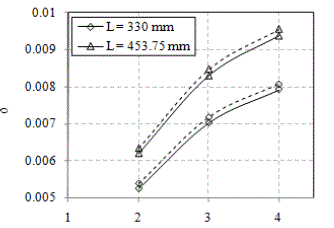 |
| Effect of the number of layers:- The use of more number of layers with the same overall beam thickness is accompanied by more friction surfaces producing higher energy loss. However, the stiffness as well as strain energy is reduced with the increased number of layers, thereby increasing the logarithmic decrement as shown in Figs. 5 and 6. |
| Effect of the specimen length:- The stiffness is decreased with the increase in the specimen length, thus reducing the input strain energy into the system as evident from Eq. (7). Moreover, the longer specimens require more number of rivets, thereby increasing the overall dynamic slip and energy loss at the interfaces. This further enhances the logarithmic decrement as evident from Fig. 6 and 7. |
CONCLUSION |
| Considering one-dimensional beam elements, a finite element procedure based on energy approach has been enumerated in the present analysis. The results so obtained establish that a substantial increase in the damping capacity can be achieved by using rivets of larger diameter with more number of layers and cantilever length. The aircraft and aerospace structures, bridges, frames, machine members, machine tools, automobiles, etc. can be effectively designed with this concept to maximize their damping capacity. |
NOMENCLATURE |
| D = global displacement vector |
| 2h = thickness of each layer of the cantilever specimen |
| I = second moment of area of the jointed beam cross-section |
| K = global stiffness matrix |
| l = length of individual elements |
| L = free length of the layered and jointed beam |
| S = shape function matrix |
| d e = nodal displacement vector of an element |
| k e = element stiffness matrix |
| v1, v2 = transverse displacement at the nodes of an element |
| θ1,θ2 = slope at the nodes of an element |
References |
|